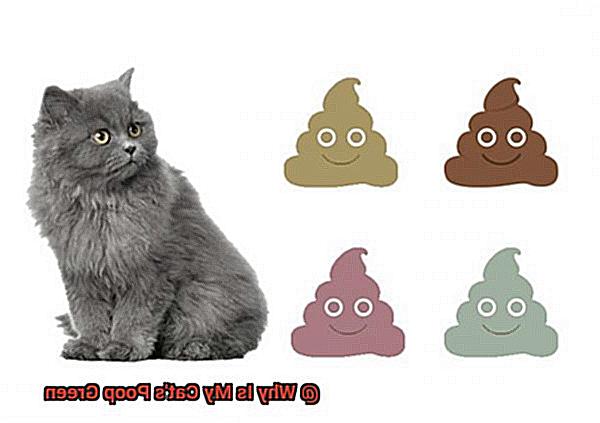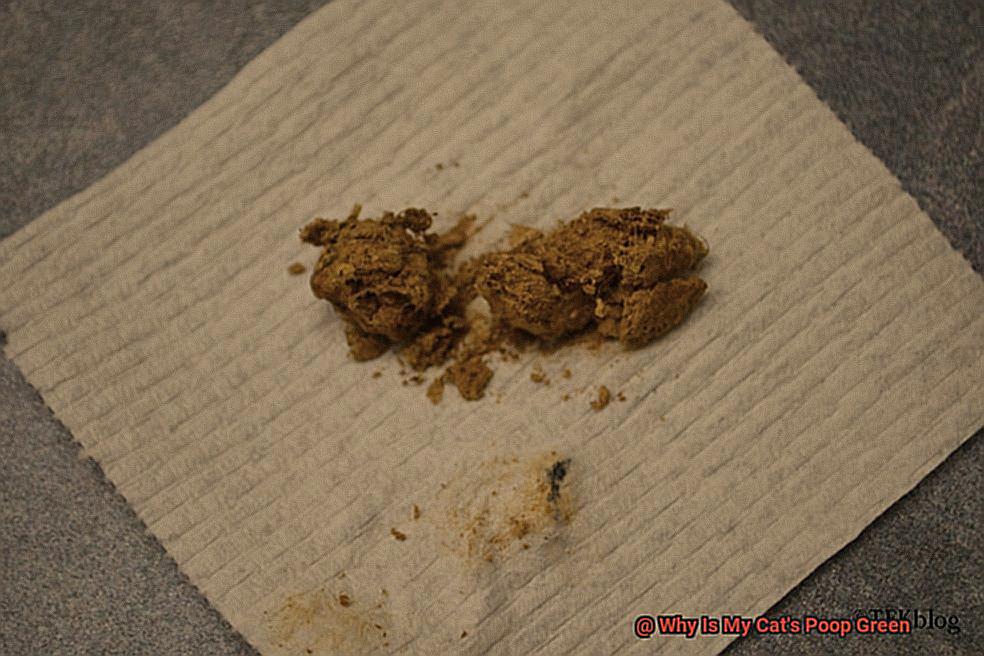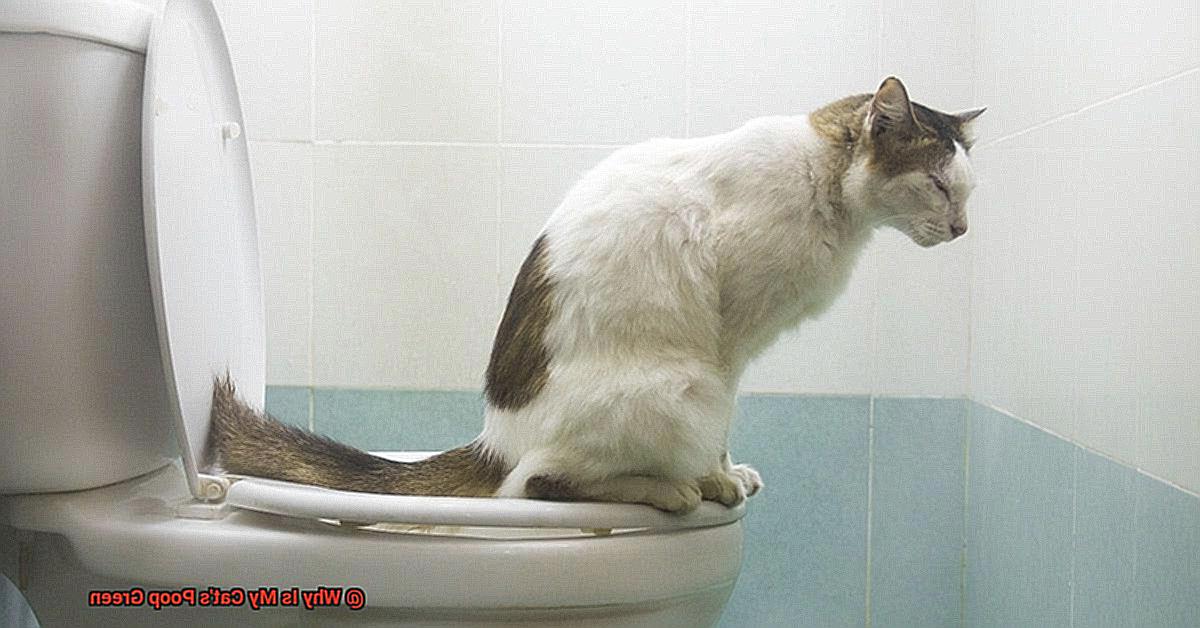Do you ever see your cat’s poop is green? Many pet owners are curious to know why their cat’s poop is green. In this blog post, we’ll look at the possible causes and how to cope.
Diet could be a factor. Cats that eat a lot of grass or other plants may have greener stool than those on a more traditional diet. If your cat has recently switched products or treats, it could be due to the ingredients in their new diet.
Infection or disease such as giardia or salmonella can cause diarrhea and other digestive issues which can also lead to green poop in cats.
It’s likely that the green color is caused by bile or bilirubin pigment from the liver’s stool, which is usually harmless and resolves on its own within a few days.
If you notice that your cat’s poops are always green, take them to the vet for testing as soon as possible so they can rule out any underlying medical conditions and provide therapy if needed.
Causes of Green Poop in Cats
Green poop in cats can be a source of worry, but it doesn’t necessarily mean something is wrong. It could be due to a change in their diet or an underlying medical condition. Here are some of the most common causes of green-colored stools so that you can better understand what may be causing this issue.
First and foremost, diet changes can cause your cat’s poop to turn green. Certain brands of cat food contain high levels of green pigments, which can change the color of your cat’s stool. If you’ve recently changed your cat’s food, it may be that the pigment has caused the green hue. Fortunately, this kind of green poop is rarely a cause for concern and should resolve itself within a few days.
Another possible explanation for green poop in cats is an underlying medical condition. Different infections and food sensitivities can also result in green-colored stools in cats. If your cat’s green poop persists for more than a few days and is accompanied by other signs such as vomiting or loss of appetite, it may be time to consult with your veterinarian for further examination.
Green mucus in your cat’s stool may indicate diarrhea, which can lead to inflammation of the intestinal lining and the presence of mucus giving it a greenish tint. Parasites such as Giardia and Coccidiosis can also cause diarrhea and result in the production of green-colored feces. Other health conditions, such as liver or pancreatic disease, can also cause changes to your cat’s stool color, including turning it green.
Diet Changes
It could be due to a sudden change in diet. Cats are extremely sensitive to dietary changes, and even the smallest deviation can cause their stool to turn green.
It’s important to introduce any new foods or treats to your cat gradually. High-fiber diets, such as those that include vegetables or fruits, can also lead to green poop in cats since their digestive systems aren’t designed to process plant matter efficiently. If you’re unsure which food is best for your cat, please consult with your veterinarian for expert advice.
If you think the green poop is being caused by diet changes, try switching to a bland and easy-to-digest diet like plain chicken or turkey meat for a few days. This should help your cat’s digestive system recover and get back on track. However, if the green poop persists for more than a few days, it’s essential to seek veterinary assistance in order to rule out any underlying health issues.
As a cat parent, it’s important to check your cat’s stool regularly and take note of any unusual changes that last longer than a few days.

Medical Conditions
If your cat’s poop has suddenly changed to green, it could be a sign of something more serious than just a change in diet. Green poop in cats can be caused by various medical conditions, such as intestinal parasites, inflammatory bowel disease (IBD), pancreatitis, or food allergies.
It is important to take note of any other changes in your cat’s behavior that may lead to the green poop. If you observe lethargy, appetite loss, or vomiting, it is essential to bring your cat to the veterinarian for an examination and potential diagnostic tests such as a fecal exam or blood work.
Green poop can be more than just a diet change – so if you spot any other signs that may indicate a health condition, don’t hesitate to seek veterinary assistance.
Food Sensitivity
Green poop in cats is a common cause of concern for pet owners, but the good news is that it can often be traced to a food sensitivity. Cats are known to have sensitive digestive systems and can develop allergies or intolerances to certain ingredients, such as dairy, gluten, and artificial additives. When this happens, inflammation in the cat’s digestive tract can occur, leading to the production of mucus and green-colored stools.
If your cat has been diagnosed with a food sensitivity, it is important to avoid feeding them foods that contain allergens. Instead, opt for high-quality hypoallergenic cat food that is free from common allergens. Additionally, introduce new foods gradually into your cat’s diet as sudden changes can cause digestive disturbances that can worsen their symptoms.
It is also essential to ensure your cat stays well-hydrated by providing plenty of fresh water and monitoring their water intake. If your cat’s green poop persists despite dietary changes, it may be time to consult with your vet for further investigation.
Gastrointestinal Tract Infections
Green poop in cats can be a cause for alarm, as it can be indicative of a more serious medical condition. One of the most common causes of this unusual coloration is a gastrointestinal tract infection, which can be caused by bacteria, viruses, or parasites. Symptoms include diarrhea, vomiting, abdominal pain, and loss of appetite. In some cases, the poop may also contain mucus or blood alongside the green color.

If your cat’s poop is green and accompanied by any other signs such as vomiting or decreased appetite, it is important to seek veterinary attention right away.
The underlying cause of the infection must be identified and treated with antibiotics, antivirals or antiparasitics in order to effectively treat the condition. Additionally, it is essential to keep your cat hydrated and maintain a healthy diet to promote healing of the digestive system.
Preventative measures such as regular deworming, maintaining good hygiene and vaccinating your cat can also help reduce the occurrence of gastrointestinal infections and stop green poop from developing in the future.
Mucus In Stool
Mucus in a cat’s stool is not uncommon and can be related to a variety of issues. While the presence of mucus can indicate that your pet is digesting their food properly, if you find green mucus in your cat’s poop, it’s important to take action.
Green mucus in your cat’s stool can reveal a variety of health concerns, from infections and parasitic infestations to inflammatory bowel disease. It could also be caused by sudden dietary changes or the ingestion of an unusual or toxic substance.
If you find green mucus in your cat’s poop, pay attention to other signs such as vomiting or blood in the stool, and consult your veterinarian right away for a thorough examination and diagnosis.

Cats are experts at hiding any signs of illness until it’s too late—so being proactive about monitoring your pet’s wellbeing is essential. Paying attention to the color and consistency of their poop will help you identify any potential problems before they become more serious.

Diarrhea and Inflammation of the Intestinal Lining
Green poop in cats can be a sign of something serious, such as diarrhea and inflammation of the intestinal lining.
Diarrhea is a common problem in cats and can be caused by various factors such as dietary changes, food allergies, parasites, or gastrointestinal infections. Inflammation of the intestinal lining, also known as colitis, can cause frequent and loose stools with mucus or blood.
The green color is caused by the presence of bile in the feces. Bile is a fluid produced by the liver and stored in the gallbladder that helps digest fat. When the digestive system is not functioning properly, bile may not be properly broken down resulting in green or yellowish-green stool.
If your cat has green poop, it is important to monitor their behavior and make sure they are still drinking water and eating food. If they are showing signs of dehydration or their symptoms persist for more than a day or two, it is best to seek veterinary assistance. The vet may recommend changes to diet, prescribe medications, or perform diagnostic tests to determine the root cause of these symptoms.
Green poop can be an alarming sign for any pet parent but taking proactive steps can help keep your feline friend healthy and happy.
How to Monitor Your Cat’s Poop Color
Being a responsible pet parent means being mindful of your cat’s poop color. While it may not be the most pleasant activity, it can help you detect any underlying health issues in your cat early and get them the medical attention they need. Here are some tips on how to monitor your cat’s poop color.
First, establish a baseline for what is normal for your cat. Pay attention to the color, consistency, and frequency of your cat’s bowel movements regularly and log any changes you notice. This will help you spot any concerning changes in their poop color quickly and take action if necessary.
Second, clean the litter box daily. Your cat should be using the litter box regularly and producing normal-colored poop in an ideal situation. If your cat isn’t using the litter box or their poop is consistently green, it’s essential to consult a veterinarian for further examination.
Be aware that certain colors may indicate a serious problem in your cat. Green-colored poop can signal a variety of conditions, but it may also indicate an underlying health condition that requires medical attention.
Additionally, red or black poop indicates blood in the stool, which could point to something serious and necessitate a visit to the vet right away.
Conclusion
Green poop in cats may be due to a change in diet, an underlying medical condition, or food sensitization.
Pay attention to your cat’s behavior and keep an eye out for any other changes that may result in green-colored stools. If you notice anything unusual, seek medical assistance right away.
To prevent green poop from developing in the future, introduce any new foods or treats to your cat gradually and opt for a high-quality hypoallergenic cat food free of common allergens.
Make sure your cat stays hydrated by providing them with plenty of fresh water and monitoring their water intake.
Being a responsible pet parent means being aware of your cat’s poop colors. Establish a baseline for your cat’s behavior and empty the litter box daily. Certain hues can indicate serious illness and require immediate veterinary care.
Regularly monitoring your cat’s poop color can help identify any underlying health conditions early on and get them the treatment they need before it’s too late.







